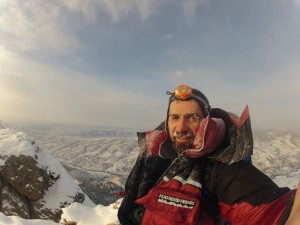Sliding the climbing rope into my pack, I carefully stacked the coils above four other ropes. When I nestled four water bottles atop the pile, the gallon of water topped off the load. A grunt escaped from my mouth as I hefted the backpack up onto one knee and guessed it’s weight. Probably about 54 pounds.
This was not preparation for some big summit push. I was just going for a hike up my local training hill – an easy to reach place that I have been to about a hundred times before. Why all the gear then? Because the key to being ready for big summits, is to train harder than you think you will ever need on the mountain.
If you think you will have to carry 30 pounds at 20,000 feet, then carry 60 pounds during training.
Train when it’s wet. Train when it’s cold.If the summit demands that you climb for 12 hours straight, then do a practice hike of 13 hours. Or more.
By training harder in practice than you think you will ever need in application, you will be ready for anything. Situations change, problems pop up, and you may not be at your best when those setbacks happen. Therefore, you must build more capacity than you think you will need. By intentionally making your practice sessions difficult, you will become more resilient, which increases your chances for safety and success. This is all true whether you are climbing a mountain, building a house, or building a company.
Here are three ways that hard training makes you more resilient:
- Physical Durability: You can do more work and endure more discomfort.
- Mental Toughness: Difficulties won’t rattle your mind. Because you now have greater abilities to accept and adapt, you’ll even embrace unexpected difficulties.
- Spiritual Strength: During all that hard training you will have integrated the work, the challenge and the opportunity into who you are.
When I go to climb Mount Everest next spring, the trip from base camp to summit (29,035 ft) is about 12 miles and 11,735 feet of ascent. In my first eight months of training, I have already hiked 352 miles and  ascended 101,688 feet. And, there is much more to do in the months ahead.
ascended 101,688 feet. And, there is much more to do in the months ahead.
Train harder than you think you’ll need. You can go further than you ever imagined.
For more on Jim’s training for Everest, click here: Training for Everest 2015.


Thanks, Jim. Sound advice in a number of areas of life.
You are welcome John Paul. Yes, many lessons about climbing apply directly to life.(and vice versa too!)